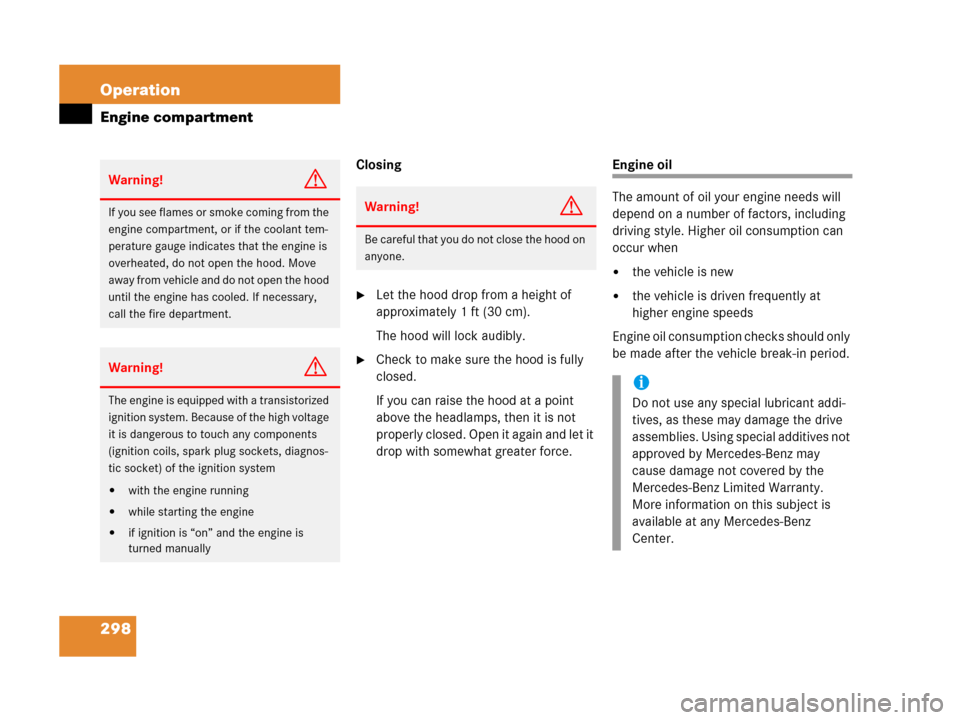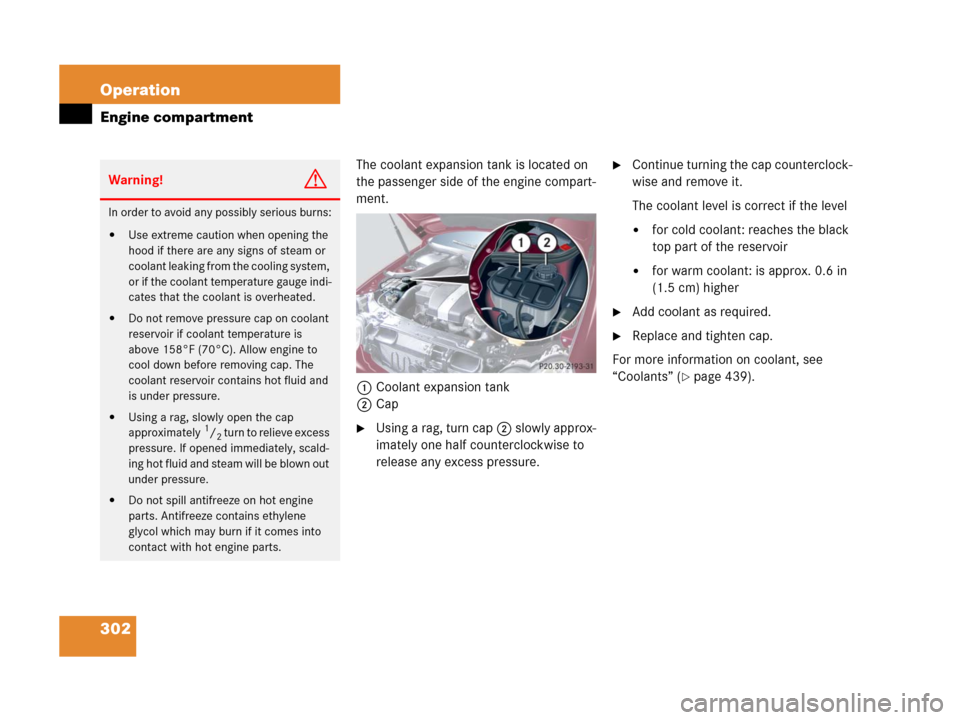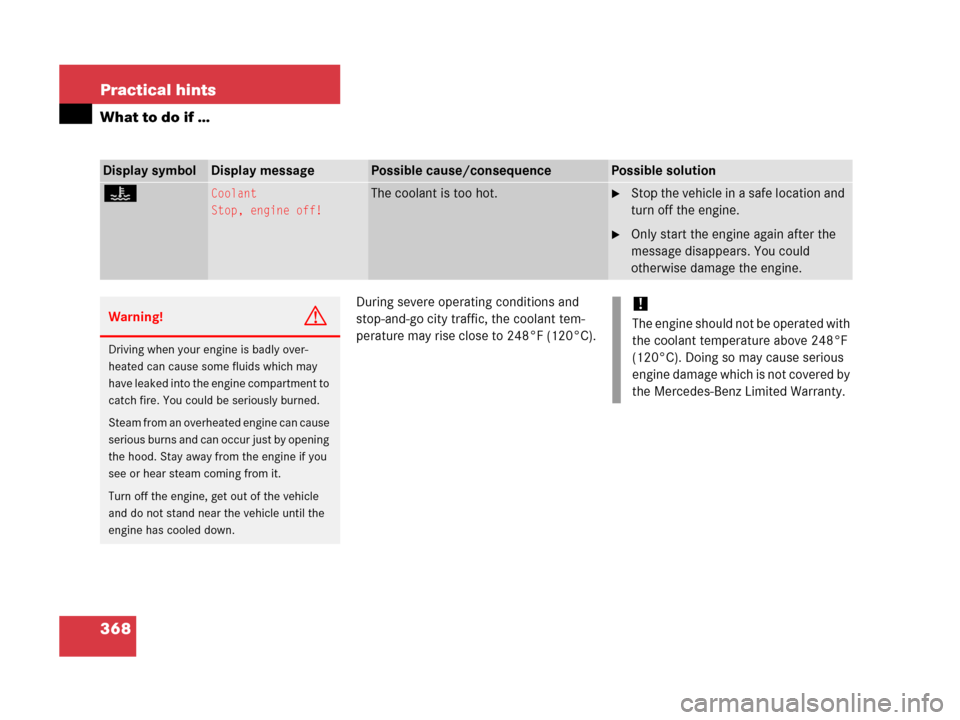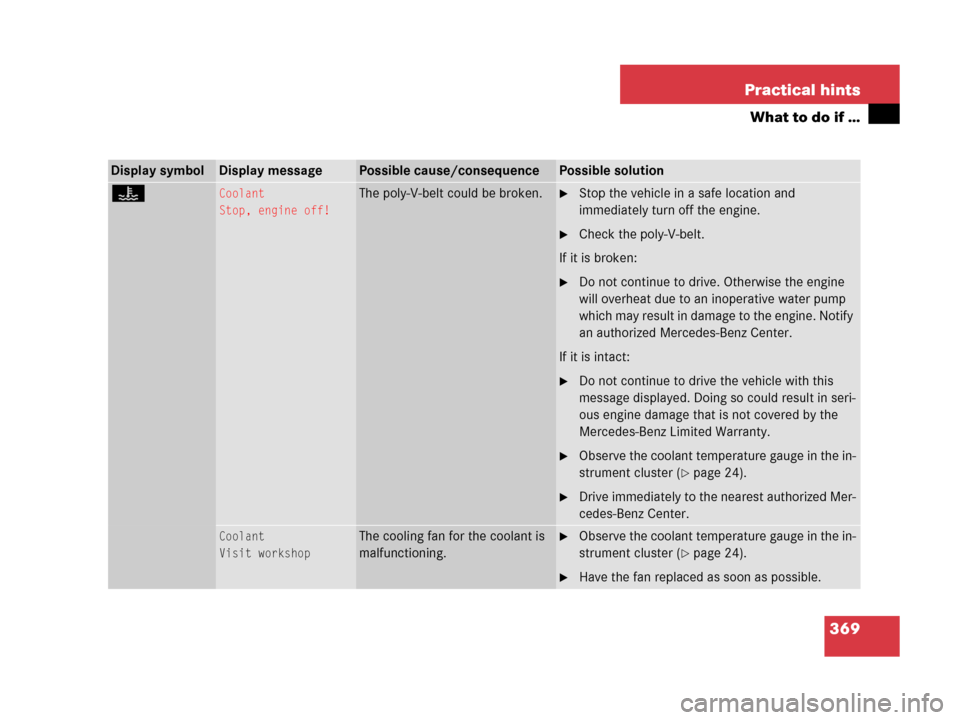Page 296 of 473

295 Operation
At the gas station
Coolant
For normal replenishing, use water (pota-
ble water quality). For more information,
see “Coolant level” (
�page 301) and
“Fuels, coolants, lubricants, etc.”
(
�page 436).
Brake fluid
Removing fuse box cover (
�page 421).Windshield washer and headlamp
cleaning system*
For more information on filling up the
washer reservoir, see “Windshield washer
system and headlamp cleaning system*”
(
�page 304).
Engine oil level
For more information on engine oil level,
see “Engine oil” (
�page 298).Vehicle lighting
Check function and cleanliness. For more
information on replacing light bulbs, see
“Replacing bulbs” (
�page 394).
Exterior lamp switch (
�page 114).
!
If you find that the brake fluid in the
brake fluid reservoir has fallen to the
minimum mark or below, have the
brake system checked for brake pad
thickness and leaks immediately.
Notify an authorized Mercedes-Benz
Center immediately. Do not add brake
fluid as this will not solve the problem.
For more information, see “Practical
hints” (
�page 351).
Page 299 of 473

298 Operation
Engine compartment
Closing
�Let the hood drop from a height of
approximately 1 ft (30 cm).
The hood will lock audibly.
�Check to make sure the hood is fully
closed.
If you can raise the hood at a point
above the headlamps, then it is not
properly closed. Open it again and let it
drop with somewhat greater force.
Engine oil
The amount of oil your engine needs will
depend on a number of factors, including
driving style. Higher oil consumption can
occur when
�the vehicle is new
�the vehicle is driven frequently at
higher engine speeds
Engine oil consumption checks should only
be made after the vehicle break-in period.
Warning!G
If you see flames or smoke coming from the
engine compartment, or if the coolant tem-
perature gauge indicates that the engine is
overheated, do not open the hood. Move
away from vehicle and do not open the hood
until the engine has cooled. If necessary,
call the fire department.
Warning!G
The engine is equipped with a transistorized
ignition system. Because of the high voltage
it is dangerous to touch any components
(ignition coils, spark plug sockets, diagnos-
tic socket) of the ignition system
�with the engine running
�while starting the engine
�if ignition is “on” and the engine is
turned manually
Warning!G
Be careful that you do not close the hood on
anyone.
i
Do not use any special lubricant addi-
tives, as these may damage the drive
assemblies. Using special additives not
approved by Mercedes-Benz may
cause damage not covered by the
Mercedes-Benz Limited Warranty.
More information on this subject is
available at any Mercedes-Benz
Center.
Page 302 of 473
301 Operation
Engine compartment
1Filler cap
�Unscrew filler cap1 from filler neck.
�Add engine oil as required. Be careful
not to overfill with oil.
Be careful not to spill any oil when adding.
Avoid environmental damage caused by oil
entering the ground or water.
�Screw filler cap1 back on filler neck.
For more information on engine oil, see the
“Technical data” section (
�page 436) and
(
�page 437).
Transmission fluid level
The transmission fluid level does not need
to be checked. If you notice transmission
fluid loss or gear shifting malfunctions,
have an authorized Mercedes-Benz Center
check the transmission.
Coolant level
The engine coolant is a mixture of water
and anticorrosion/antifreeze. To check
the coolant level, the vehicle must be
parked on level ground and the engine
must be cool.
!
Excess oil must be siphoned or drained
off. It could cause damage to the
engine and catalytic converter not
covered by the Mercedes-Benz Limited
Warranty.
Page 303 of 473

302 Operation
Engine compartment
The coolant expansion tank is located on
the passenger side of the engine compart-
ment.
1Coolant expansion tank
2Cap
�Using a rag, turn cap2 slowly approx-
imately one half counterclockwise to
release any excess pressure.
�Continue turning the cap counterclock-
wise and remove it.
The coolant level is correct if the level
�for cold coolant: reaches the black
top part of the reservoir
�for warm coolant: is approx. 0.6 in
(1.5 cm) higher
�Add coolant as required.
�Replace and tighten cap.
For more information on coolant, see
“Coolants” (
�page 439).
Warning!G
In order to avoid any possibly serious burns:
�Use extreme caution when opening the
hood if there are any signs of steam or
coolant leaking from the cooling system,
or if the coolant temperature gauge indi-
cates that the coolant is overheated.
�Do not remove pressure cap on coolant
reservoir if coolant temperature is
above 158°F (70°C). Allow engine to
cool down before removing cap. The
coolant reservoir contains hot fluid and
is under pressure.
�Using a rag, slowly open the cap
approximately1/2 turn to relieve excess
pressure. If opened immediately, scald-
ing hot fluid and steam will be blown out
under pressure.
�Do not spill antifreeze on hot engine
parts. Antifreeze contains ethylene
glycol which may burn if it comes into
contact with hot engine parts.
Page 368 of 473
367 Practical hints
What to do if …
Display symbolDisplay messagePossible cause/consequencePossible solution
BCoolant
Check levelThe coolant level is too low.�Add coolant (�page 301).
�If you have to add coolant frequently,
have the cooling system checked by
an authorized Mercedes-Benz Center.
Warning!G
Do not spill antifreeze on hot engine parts.
Antifreeze contains ethylene glycol which
may burn if it comes into contact with hot
engine parts. You can be seriously burned.
!
Do not ignore the low engine coolant
level warning. Extended driving with
the message and symbol displayed
may cause serious engine damage not
covered by the Mercedes-Benz Limited
Warranty.
Do not drive without sufficient amount
of coolant in the cooling system. The
engine will overheat causing major
engine damage.
Page 369 of 473

368 Practical hints
What to do if …
During severe operating conditions and
stop-and-go city traffic, the coolant tem-
perature may rise close to 248°F (120°C).
Display symbolDisplay messagePossible cause/consequencePossible solution
•Coolant
Stop, engine off!The coolant is too hot. �Stop the vehicle in a safe location and
turn off the engine.
�Only start the engine again after the
message disappears. You could
otherwise damage the engine.
Warning!G
Driving when your engine is badly over-
heated can cause some fluids which may
have leaked into the engine compartment to
catch fire. You could be seriously burned.
Steam from an overheated engine can cause
serious burns and can occur just by opening
the hood. Stay away from the engine if you
see or hear steam coming from it.
Turn off the engine, get out of the vehicle
and do not stand near the vehicle until the
engine has cooled down.
!
The engine should not be operated with
the coolant temperature above 248°F
(120°C). Doing so may cause serious
engine damage which is not covered by
the Mercedes-Benz Limited Warranty.
Page 370 of 473

369 Practical hints
What to do if …
Display symbolDisplay messagePossible cause/consequencePossible solution
•Coolant
Stop, engine off!The poly-V-belt could be broken.�Stop the vehicle in a safe location and
immediately turn off the engine.
�Check the poly-V-belt.
If it is broken:
�Do not continue to drive. Otherwise the engine
will overheat due to an inoperative water pump
which may result in damage to the engine. Notify
an authorized Mercedes-Benz Center.
If it is intact:
�Do not continue to drive the vehicle with this
message displayed. Doing so could result in seri-
ous engine damage that is not covered by the
Mercedes-Benz Limited Warranty.
�Observe the coolant temperature gauge in the in-
strument cluster (
�page 24).
�Drive immediately to the nearest authorized Mer-
cedes-Benz Center.
Coolant
Visit workshopThe cooling fan for the coolant is
malfunctioning.�Observe the coolant temperature gauge in the in-
strument cluster (
�page 24).
�Have the fan replaced as soon as possible.
Page 424 of 473
423 Technical data
Parts service
Warranty coverage
Identification labels
Layout of poly-V-belt drive
Engine
Rims and Tires
Electrical system
Main dimensions and weights
Fuels, coolants, lubricants, etc.